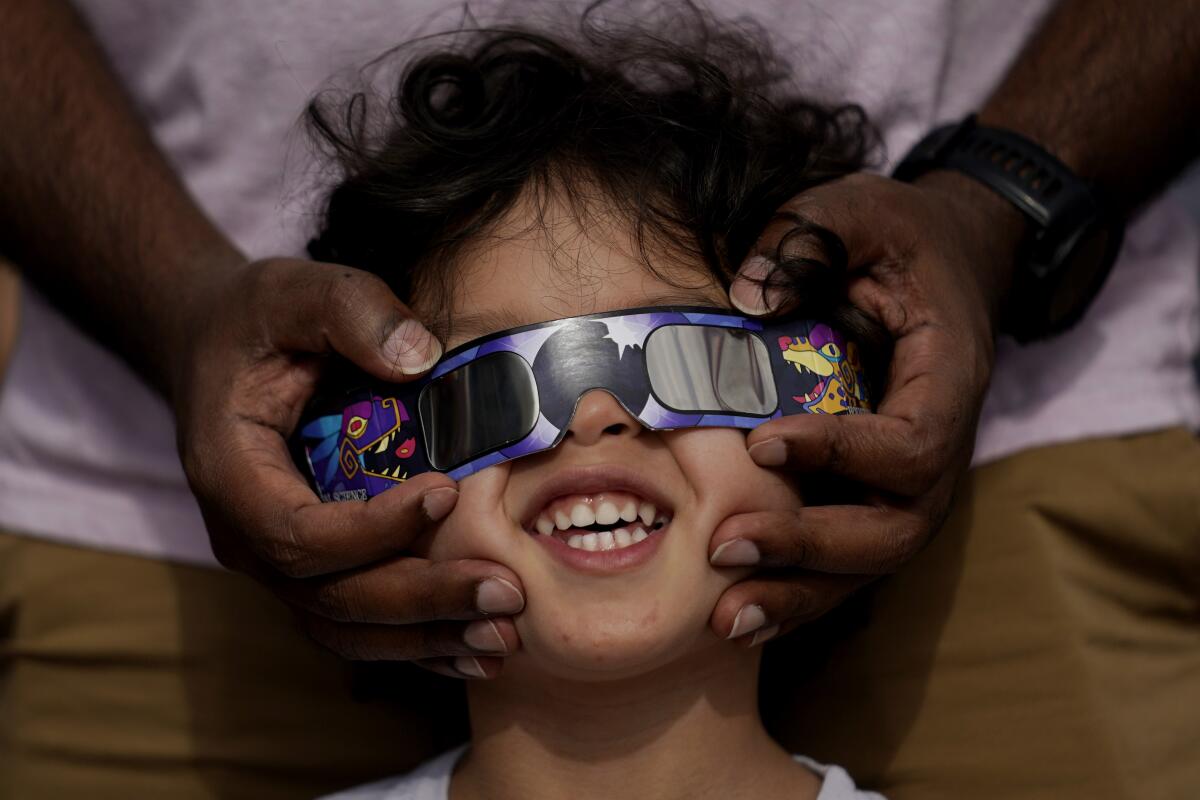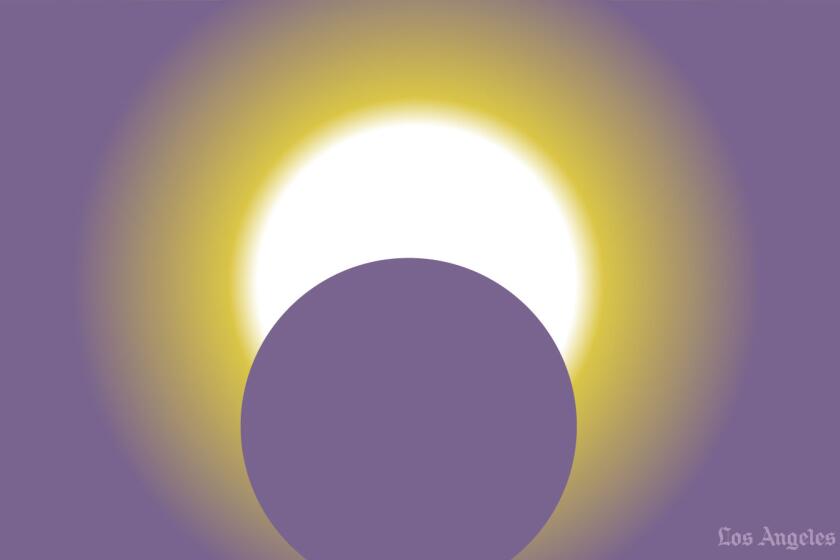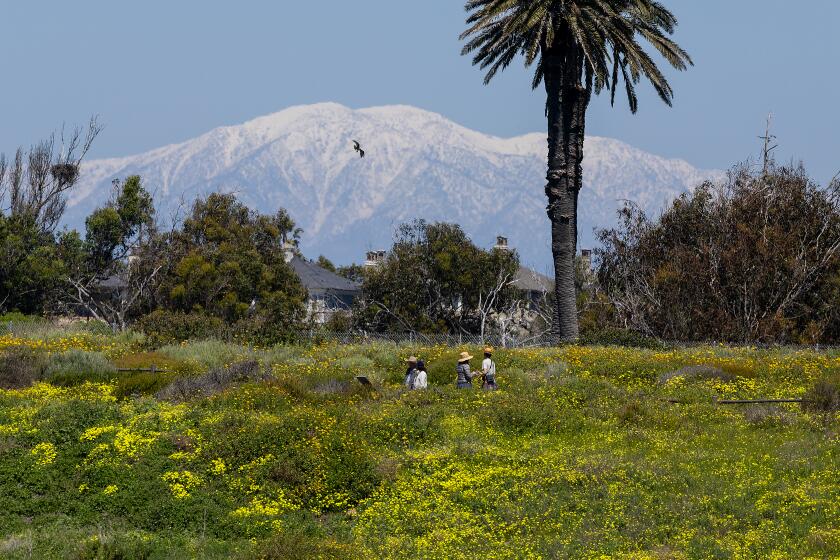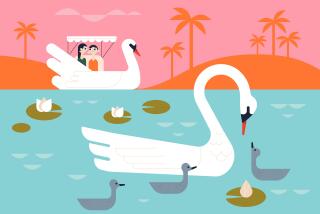Preparing for Monday’s solar eclipse: What you need to do to watch safely

- Share via
Grab your eclipse glasses — weather permitting, Los Angeles County and the rest of California will catch a glimpse of the rare total eclipse Monday.
Unfortunately for eclipse fanatics on the West Coast, Californians will be able to see only a partial eclipse. From this state’s vantage point, the moon and sun won’t be exactly aligned, and only a portion of the sun’s disc is blocked, according to the Griffith Observatory.
The moon’s encroachment into the sun’s path will start at 10:06 a.m. and it will have made a substantial bite into the sun’s image by 10:39 a.m. The eclipse will peak at 11:12 a.m. and be over by 12:22 p.m., according to the observatory.
Though there won’t be totality in California, the state will still enjoy an impressive partial eclipse in the late morning — if the skies remain cloud-free.
Depending on where you are in the state, you’ll get a slightly different view of the eclipse. For example, in Los Angeles half of the sun will be visibly covered by the moon, but in San Francisco only a third of it will be covered. Anglenos can take that as a win.
NASA offers an eclipse explorer online map if you want to time your viewing just right.
This is a rare event; the next solar eclipse that can be seen from California won’t occur until 2044. To help you prepare, experts share how you can view the eclipse safely, where to get protective eyewear, how to photograph the eclipse and who will be hosting public viewing parties in Los Angeles County.
How to safely watch the eclipse
The first rule of a solar eclipse is, don’t look at the sun without specialized eclipse glasses or a solar viewers. It’s not safe.
If you look up at the eclipse without protection, it will instantly cause severe eye injury, according to NASA.
The same rule applies for looking at the eclipse through a camera lens, binoculars, telescope or regular sunglasses. According to NASA, the concentrated solar rays will burn through the lens filter and seriously harm your eyes.
What you can use are solar viewers or eclipse glasses that comply with the ISO 12312-2 international standard. These glasses reduce visible sunlight to safe and comfortable levels and block all but a tiny fraction of solar UV and infrared radiation, according to the American Astronomical Society.
The society warns that some eclipse glasses are labeled as ISO-compliant but have not been properly tested. Unfortunately, there’s no way for you to be able to test whether the eclipse glasses are legitimate or not before you buy them. Instead, the society shares a list of reputable suppliers of eclipse glasses, viewers and filters online.
Temperatures on Thursday are expected to drop 20 degrees in some areas from Wednesday’s highs as a cold storm blows across California. Some regions could feel historic low temperatures.
Once you have some eclipse glasses in hand, here’s how to tell whether they’re safe. Through a pair of eclipse glasses you should be able to see only the sun (or something comparably bright) and nothing else. Some signs that the viewer might not be safe are:
- If you can see shaded lamps or other common household light fixtures, don’t use it.
- If you glance at the sun through the viewer and find it uncomfortably bright, don’t use it. Safe solar filters produce a view of the sun that is comfortably bright and in focus.
The American Astronomical Society advises against purchasing whatever eclipse glasses pop up in an internet search or online ads. What you can count on are glasses and viewers from a science museum, planetarium or an astronomy trade show.
When you do get a pair of glasses or viewers, make sure they’re in good condition. If the viewers are torn, scratched or punctured, discard them. If the filters are coming loose from their cardboard or plastic frames, discard them.
You can also indirectly see the eclipse by using a pinhole projection. With the sun behind you, allow the sunlight to pass through a small opening and project a solar image onto a nearby surface. Do not look at the sun through the pinhole.
There are several items you can use to fashion a pinhole projector, such as an index card with a hole punched in it, a pasta colander, a straw hat (with visible holes) or even your bare hands.
Experts such as Ed Krupp, longtime director of the Griffith Observatory, advise against staring at the eclipse for minutes on end, even with proper eye protection.
Krupp suggests looking up for just a moment to see the progress, then waiting 10 minutes or so before seeing how it looks again.
Where to get eclipse glasses
- Several branches of the Los Angeles Public Library are handing out free solar eclipse glasses every day until Saturday, but just to the first 40 people who ask for them. The library’s main online calendar lists the branches that are participating.
- The Los Angeles Public Library also will be distributing 21,000 solar eclipse glasses at the Los Angeles Maker Faire on Saturday from 9 a.m. to 6 p.m. at the Los Angeles State Historic Park in Chinatown.
- The Los Angeles County Library branches are providing the community with the protective eyeware while supplies last. The county has a list of its branch locations and contact information so you can call ahead to check on the branch’s supply.
- Participating Warby Parker locations are handing out free solar eclipse glasses while supplies last. The website for the prescription glasses retailer has a list of locations that are giving out the protective glasses.
Tips on taking a photo of the eclipse with your phone
Your eyes aren’t the only thing you shouldn’t point at the sun. Your smartphone can also be damaged if you point its camera lens at the sun for long periods of time without a special filter.
It’s generally OK to include the sun in a photo focused on something else — for example, if you’re taking a landscape photo that includes the sun, that isn’t a safety issue for the camera. If you’re focused on the sun, put eclipse glasses or certified solar filters over the camera lens.
Here are some tips for taking photos of Monday’s upcoming solar eclipse without ruining your smartphone.
Eclipse viewing events
Eclipse events around Los Angeles are all taking place from 10 a.m. to noon Monday.
- The California Science Center is hosting a hands-on educational activities and viewing of the eclipse, which is included with the center’s free general admission. Free eclipse glasses will be available.
- Cal State L.A.’s Honors College will be providing its students and the public with viewing glasses and a space to view the eclipse between the Biological Sciences Building and the Annenberg Science Complex. For more information, call (323) 343-5969 or email [email protected].
- In celebration of National Library week, 10 of L.A. County Public Library branches are hosting an educational viewing of the eclipse. The participating branches are Stevenson Ranch, El Camino Real, Lloyd Taber-Marina del Rey, Chet Holifield, Diamond Bar, Acton Agua Dulce, Manhattan Beach, Rowland Heights, Woodcrest and Lake Los Angeles. Call the participating branch for more information.
- Los Angeles Pierce College is hosting an eclipse party that’s open to the public on the second floor balcony of the Center for the Sciences on campus. Staff will provide solar eclipse glasses and have solar telescopes on site. Any questions or requests for special accommodations should be emailed to Dale Fields at [email protected].
- Caltech is hosting a viewing party for the public at the Cahill Center for Astronomy and Astrophysics. Eclipse glasses will be provided while supplies last, and a solar telescope will be on site. Astrophysicists will be available during the viewing to help everyone get the most out of the rare experience. For more information, visit Caltech’s website or email Cameron Hummels at [email protected].
- If you’re looking to virtually see the moon’s passing, the Griffith Observatory will broadcast the total solar eclipse live on Youtube from Belton, Texas.
More to Read
Sign up for Essential California
The most important California stories and recommendations in your inbox every morning.
You may occasionally receive promotional content from the Los Angeles Times.














